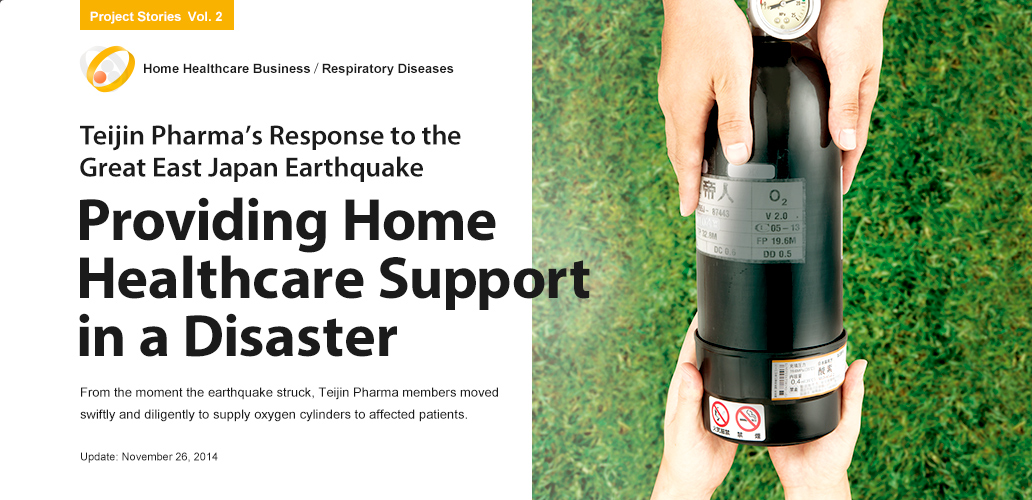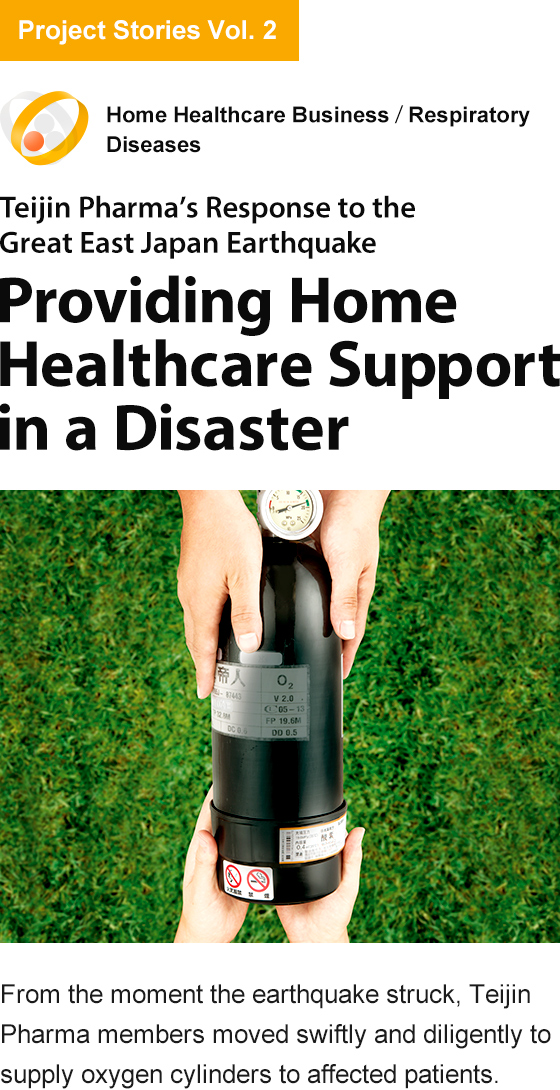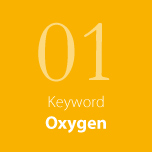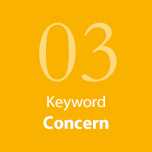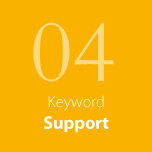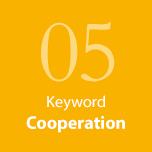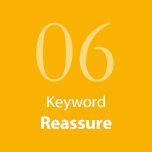
Over 150,000 people across Japan use Home Oxygen Therapy (HOT) for conditions such as chronic respiratory failure. Making use of oxygen concentrators and other equipment that facilitate the inhalation of oxygen at home, HOT allows patients to be discharged from the hospital once symptoms subside to help improve quality of life. Unfortunately, oxygen concentrators require electricity. During a power outage such as during a natural disaster, patients can easily switch to an oxygen cylinder, which is portable and compact for convenient use out of the home, but does not last as long. The Great East Japan Earthquake of March 11, 2011 brought this stark reality to light more than ever before, presenting us with the most difficult challenge we had ever faced in the 30 years of our oxygen concentrator rental business.

Since our home oxygen business began, we have had a 24-hour, 365-day response system in place for times of emergency or disaster. Based on our experiences in the 1995 Great Hanshin-Awaji Earthquake and the 2007 Niigata-Chuetsu Offshore Earthquake, we have developed a diverse array of emergency-response measures. One in particular is the Emergency Response Support IT System, Disaster Mapping Assistant Partner (D-MAP), which helps us check on our at-home patients the moment a disaster hits. When D-MAP receives information about earthquakes at or above a specific seismic intensity, it automatically identifies patients in the disaster area and emails notifications to members' computers and mobile phones. Within 10 minutes from when the Great East Japan Earthquake struck, we had compiled a list of approximately 25,000 patients. Immediately, our Tokyo disaster support headquarters began calling every one of these patients to check on their safety.

Our staff deployed in the disaster area was anxious to get oxygen cylinders to our patients as soon as possible. As we carried out this critical task, we were able to confirm their safety. In the disaster area, roads and communication networks were cut off and our offices and members’ homes were damaged. The tsunami flooded one of our offices and two of our affiliated oxygen cylinder filling stations on the coast, and many of our oxygen cylinders in storage were swept away. Needless to say, we were unable to operate as we had wanted to.
Prior to the disaster, our members had frequently visited patient homes to perform regular maintenance and inspection on oxygen concentrators. Having established these relationships, it was impossible for us to get the faces of our patients and their families out of our minds during the disaster. More than anything else, we wanted to check on their safety and get them the oxygen cylinders that they required. With this as our sole purpose, we delivered the cylinders while rushing to the homes of patients whose phones had been disconnected to assure their safety. Our staff spread out, gathering information at evacuation sites, while others hurried to medical gas companies to source extra oxygen cylinders. Even as aftershocks continued we did everything we could to help our patients.
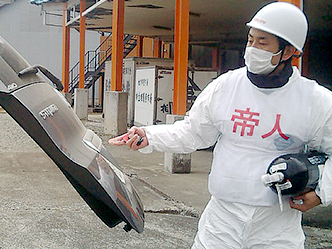 Delivery of oxygen cylinders to patients' homes
Delivery of oxygen cylinders to patients' homes
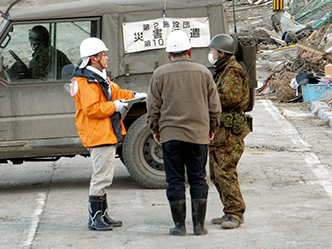

For nearly five straight months, Teijin Group companies sent support personnel and supplies from across Japan to assist our members in the disaster area. We prepared emergency shipments, including nearly 20,000 oxygen cylinders and over 600 oxygen concentrators, and maintained the level of support personnel throughout the effort. We automatically transferred calls to our offices in the disaster area, which had poor telephone service, to our Customer Center in order to handle calls on a 24-hour basis. During the rolling blackouts, Tokyo members worked through the night to contact and inform patients in designated blackout areas as we put the full weight of the Group behind our efforts to overcome this challenging situation. At this point, we still faced numerous problems as we were unable to contact some patients, and questions remained over how to provide care to those living in evacuation sites.
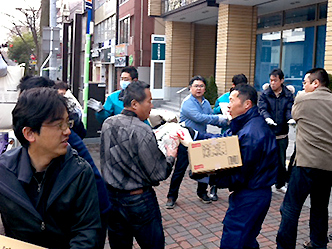 Teijin members aiding in relief efforts
Teijin members aiding in relief efforts
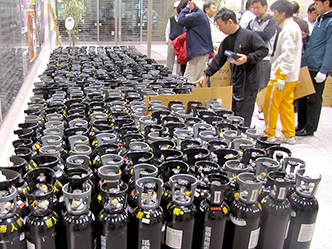 Oxygen cylinders delivered to Sendai
Oxygen cylinders delivered to Sendai

Many of the evacuated patients were taken to hospitals and public facilities. Within five days of the earthquake, Teijin Pharma had facilitated the opening of a temporary HOT Station, placing 50 oxygen concentrators in the district hospital of the coastal area that had suffered severe tsunami damage. We also installed over 100 oxygen concentrators, primarily in medical institutions serving as evacuation sites, so that in addition to treating our patients, we were able to supply oxygen concentrators to anyone in need. We mobilized successfully to verify the safety of most of our patients, while others contacted our Customer Center directly. In just two weeks after the earthquake, we had confirmed the status of 98.8% of our patients, and by the end of March that had risen to 99.8%.
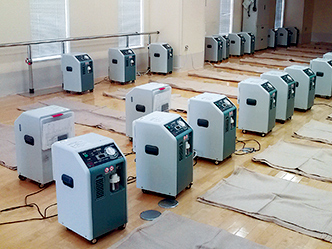 Opened a temporary HOT Station at a district hospital in the disaster area
Opened a temporary HOT Station at a district hospital in the disaster area

While the scars of the Great East Japan Earthquake remain, we must continue to improve and refocus our attention on disasters elsewhere. In addition to updating our Emergency Response Manual based on our firsthand experiences with disaster, we have upgraded D-MAP and increased our oxygen cylinder reserves. And to make it easier for patients to contact us, we have added a new Customer Center in Osaka to assist our existing center in Fukuoka. In an effort to ensure reliable communications, we have installed satellite phones at all branches, as well as battery-powered and line-powered telephones at all business locations. The enormous magnitude of the disaster resulted in damage to all the hospitals, oxygen business operators, roads and transportation networks in the area, greatly limiting our ability to act immediately after the disaster struck. This taught us a valuable lesson on the importance of being prepared and of coordinating with relevant agencies. As a means to preempt and minimize difficulties during a future disaster, we are distributing pamphlets that encourage patients to review use of the oxygen cylinders and to note the Teijin Pharma emergency contact information. We will continue to strive to be better prepared, offering patients and their families access to the supplies they need and the peace of mind they deserve.




